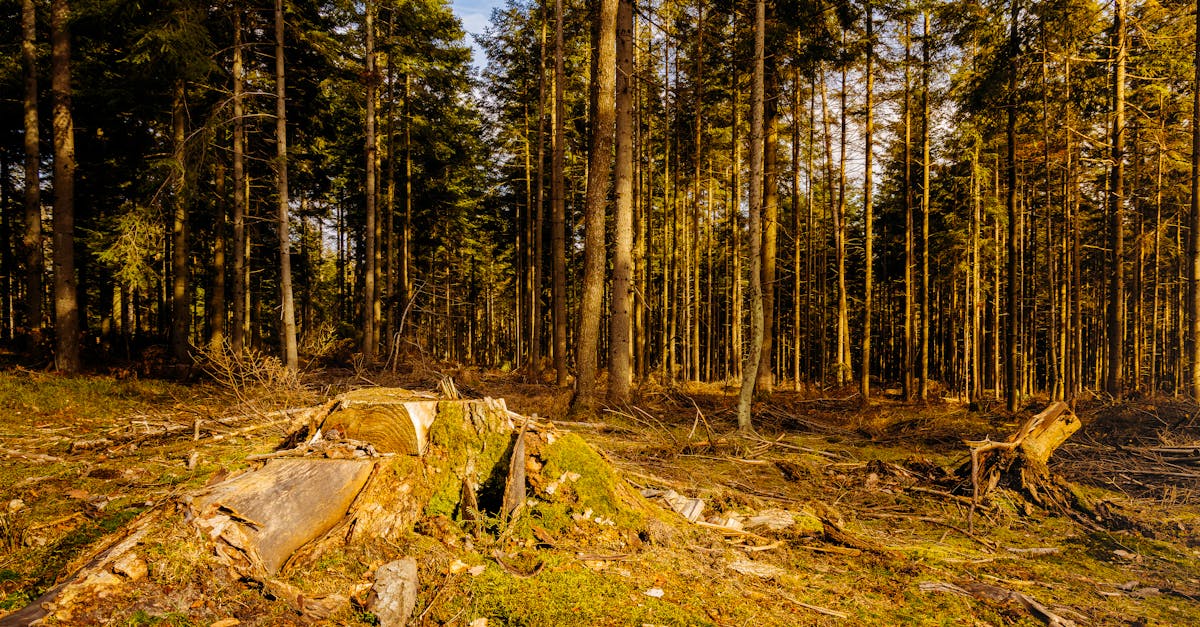Unearthing the Subterranean Ecosystems: Tree Stumps as Superorganism Sanctuaries

Delving into the enigmatic microcosm thriving within seemingly ordinary tree stumps reveals a world of complexity and interconnected life forms, shaping ecosystems in unexpected ways. While often overlooked, these remnants play a pivotal role in nurturing a hidden realm teeming with vitality. By exploring the intricate networks of superorganisms ensconced within these stumps, we begin to unravel the profound significance of these often-neglected structures. Viewing tree stumps through a different lens illuminates the rich tapestry of life sustained within them, showcasing their role as vibrant hubs of biodiverse activity.
1. Introduction to Tree Stumps
Thank you for reading this post, don't forget to subscribe!
Tree stumps, often perceived as mere remnants of once towering entities, play a crucial role in natural environments, serving as focal points for a myriad of ecological processes. Understanding the significance and role of tree stumps delves into the intricate balance of decay and renewal within ecosystems. As trees reach the end of their lifecycle, the resulting stumps become vital platforms for the regeneration of life, providing an array of habitats for a diverse community of flora and fauna. Their decomposition nurtures new growth, emphasizing the cyclical nature of life within the natural world. Furthermore, tree stumps serve as reservoirs for moisture and nutrients, contributing to the sustenance of surrounding plant life and small organisms. Through understanding the underappreciated role of tree stumps, we gain insight into the complex web of interconnected life forms that thrive within these seemingly inert structures.
2. The Secret Life of Tree Stumps

The enigmatic world concealed within decaying tree stumps brings to light a rich tapestry of interconnected ecosystems, each playing a crucial role in sustaining a vibrant microcosm. As tree stumps undergo progressive decay, a plethora of organisms take residence within their porous, decaying mass, orchestrating a harmonious symphony of life and decay. Fungi, in particular, play a pivotal role in this intricate system, weaving expansive mycelial networks that foster symbiotic relationships with various plant species and contribute to nutrient cycling. Beyond fungi, an array of insects, microorganisms, and small vertebrates find sustenance and shelter within this decomposing realm, fueling a complex food web that thrives beneath the surface. The decomposing tree stumps also foster the growth of diverse plant species, further enhancing the biodiversity within these often-overlooked ecosystems.
3. Superorganisms: Unseen Complexity
Within the seemingly inert confines of tree stumps lies an unseen universe of interconnected life forms, fostering a level of complexity that often eludes casual observation. Fungal networks, for instance, form a fundamental component of this hidden world, intricately weaving through the decaying wood in expansive, interconnected mycelial webs. These networks not only facilitate the decomposition of the stump but also form symbiotic relationships with neighboring plants, enabling the exchange of nutrients and contributing to the overall health of the ecosystem. Additionally, diverse microbial communities thrive within this decomposing environment, actively participating in nutrient cycling and contributing to the vitality of the ecosystem. The collaborative efforts of these superorganisms within tree stumps highlight the profound interdependence and hidden complexity of life in even the most inconspicuous natural settings.
Fungal Networks
Fungi, particularly through their mycelial networks, form expansive underground structures that fundamentally contribute to the vitality and sustainability of various ecosystems. These intricate networks, often hidden from view, play a pivotal role in nutrient cycling and resource distribution, serving as conduits for the exchange of essential elements among plants and other organisms. As these mycelial networks proliferate, they establish symbiotic relationships with plant roots, facilitating the absorption of water and essential nutrients while also aiding in pathogen resistance. Furthermore, these networks play a crucial role in the decomposition of organic matter, breaking down complex compounds and enriching the surrounding soil. Their impact extends beyond the immediate vicinity, influencing the health and diversity of the entire ecosystem. By examining the elaborate tapestry of fungal networks, we gain a deeper understanding of the interconnectedness and resilience of natural systems, illustrating the critical role these often overlooked organisms play in maintaining ecological balance.
Microbial Communities
Investigating the complex and diverse microbial communities thriving within tree stumps unveils a vibrant ecosystem of microscopic life forms that are instrumental in facilitating the decomposition and nutrient cycling processes. These communities encompass a rich assortment of bacteria, archaea, and other microorganisms that actively participate in breaking down organic matter, releasing vital nutrients, and influencing soil structure. Despite their diminutive size, these microorganisms play a crucial role in sustaining the life cycle within tree stumps, contributing to the overall health and biodiversity of surrounding environments. Moreover, their interactions with other organisms, such as fungi and plant roots, create a dynamic web of interdependence, reflecting the intricate balance required for ecosystem sustainability.
4. The Role of Tree Stumps in Biodiversity

Tree stumps serve as vital hubs of biodiversity, fostering a rich tapestry of flora and fauna within their decaying forms. As these remnants slowly decompose, they become focal points for a diverse array of organisms, including fungi, lichens, mosses, insects, small mammals, and various plants. The cavities and crevices within decaying stumps provide shelter and nesting sites for numerous species, contributing to the overall biodiversity of the surrounding environment. Additionally, the gradual breakdown of the stump creates a fertile ground for the growth of new plant life, further enhancing the diversity of the area. Ultimately, the presence of tree stumps significantly enriches the ecological landscape, providing a myriad of niches that support a wide range of species and contribute to the overall balance of the ecosystem.
5. Environmental Impact and Conservation
The removal or preservation of tree stumps has a significant impact on environmental stability and biodiversity. When stumps are removed, the intricate ecosystems they support are disrupted, leading to potential ramifications for the surrounding flora and fauna. Preservation of tree stumps, on the other hand, contributes to the overall health and balance of ecosystems, providing vital habitats and fostering biodiversity. The decision to remove or preserve tree stumps necessitates a careful consideration of the potential consequences on local ecosystems, as their presence or absence can influence soil structure, moisture retention, and the availability of habitats for various species. An in-depth discussion regarding the environmental impact of managing tree stumps is crucial for developing sustainable approaches that prioritize the preservation of biodiversity and ecological stability.
6. Innovative Uses and Sustainable Practices
Modern approaches are being developed to leverage the benefits of tree stumps while ensuring sustainability. One innovative practice involves repurposing tree stumps as natural habitats or as components of biodiverse landscaping, thereby preserving their ecological value. Additionally, utilizing tree stumps in the creation of natural art installations or as elements of sustainable design showcases their aesthetic potential while retaining their role in the environment. Moreover, the integration of tree stumps into sustainable forestry practices, such as in situ decay processes and selective retention, demonstrates a commitment to maintaining ecological balance while utilizing natural resources. Exploring these modern practices not only capitalizes on the inherent ecological benefits of tree stumps but also aligns with the growing emphasis on sustainable utilization of natural resources.
Why are tree stumps important in natural environments?
Tree stumps play a crucial role by providing habitats for a diverse range of organisms, contributing to nutrient cycling, and offering structural support for new plant growth. They act as focal points for biodiversity and are integral to the ecological balance of natural environments.
Do tree stumps contribute to ecosystem sustainability?
Yes, tree stumps contribute significantly to ecosystem sustainability by supporting diverse forms of life, aiding in the decomposition process, and fostering nutrient cycling. They act as reservoirs for moisture and nutrients, enabling the regeneration of plant life while providing habitats for various organisms.
How can the removal of tree stumps affect the environment?
The removal of tree stumps can disrupt intricate ecosystems, leading to a decline in biodiversity and impacting soil structure. It may also result in the loss of vital habitats and affect the overall balance and health of the surrounding environment.
What can be done to preserve tree stumps sustainably?
Preserving tree stumps can be achieved through practices such as selective retention in forestry management, utilizing them as natural habitats in landscaping, or incorporating them into sustainable design and art installations. These approaches allow for the conservation of tree stumps while maintaining their ecological value.




